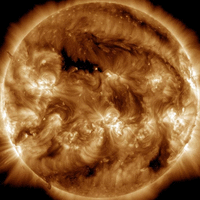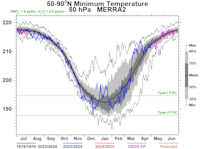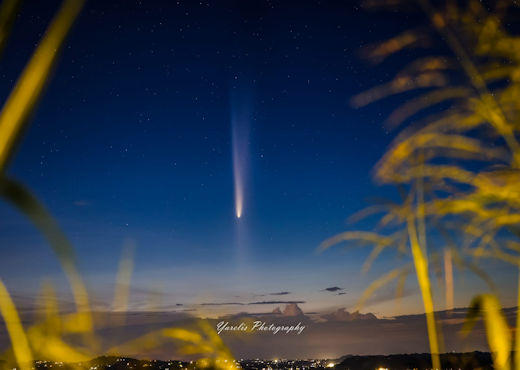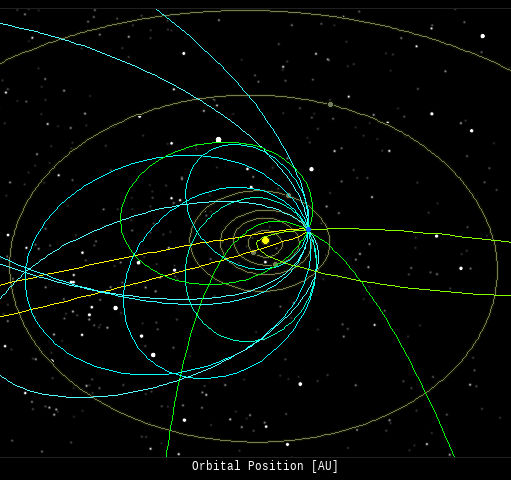 | | | Switch to: Europe, USA, New Zealand, Antarctica Credit: NOAA/Ovation  Planetary K-index Planetary K-index
Now: Kp= 2.33 quiet
24-hr max: Kp= 2.33 quiet
explanation | more data
Interplanetary Mag. Field
Btotal: 7.89 nT
Bz: -3.58 nT south
more data: ACE, DSCOVR
Updated: Today at 1147 UT  Coronal Holes: 14 Oct 24 Coronal Holes: 14 Oct 24 
There are no significant equatorial coronal holes on the Earth-facing side of the sun. Credit: SDO/AIA  Polar Stratospheric Clouds
Colorful Type II polar stratospheric clouds (PSC) form when the temperature in the stratosphere drops to a staggeringly low -85C. NASA's MERRA-2 climate model predicts when the air up there is cold enough: 
On Oct. 14, 2024, the Arctic stratosphere is much too warm for Type II polar stratospheric clouds. | more data. Noctilucent Clouds
The northern season for NLCs is underway--but not for long. The first clouds were detected inside the Arctic Circle on May 25, 2024, by the NOAA 21 satellite. After peaking in July, the clouds are now in rapid decline. This is typical for the month of August, which usually brings the end of NLC season in the northern hemisphere.

Updated: Aug. 28, 2024
An instrument onboard NOAA 21 (OMPS LP) is able to detect NLCs (also known as "polar mesospheric clouds" or PMCs). In the daily map, above, each dot is a detected cloud. As the season progresses, these dots will multiply in number and shift in hue from blue to red as the brightness of the clouds intensifies.
 SPACE WEATHER
NOAA Forecasts | | Updated at: 2024 Oct 14 2200 UTC FLARE | 0-24 hr | 24-48 hr | CLASS M | 55 % | 55 % | CLASS X | 10 % | 10 % |  Geomagnetic Storms: Geomagnetic Storms:
Probabilities for significant disturbances in Earth's magnetic field are given for three activity levels: active, minor storm, severe storm Updated at: 2024 Oct 14 2200 UTC Mid-latitudes | 0-24 hr | 24-48 hr | ACTIVE | 30 % | 40 % | MINOR | 10 % | 25 % | SEVERE | 01 % | 05 % | High latitudes | 0-24 hr | 24-48 hr | ACTIVE | 15 % | 10 % | MINOR | 30 % | 25 % | SEVERE | 40 % | 65 % | | | |  | | | | | | | | | | | This is an AI Free Zone! Text created by Large Language Models is spreading rapidly across the Internet. It's well-written, artificial, frequently inaccurate. If you find a mistake on Spaceweather.com, rest assured it was made by a real human being. | | | GEOMAGNETIC STORM WATCH (G1): Minor G1-class geomagnetic storms are possible on Oct. 15th and 16th due to a CME now en route to Earth. It was launched from sunspot AR3854 on Oct. 11th, and is expected to deliver only a glancing blow. CME impact alerts: SMS Text COMET TSUCHINSHAN-ATLAS HAS AN 'ANTI-TAIL' (UPDATED): Today is a special day for Comet Tsuchinshan-ATLAS. Earth is passing through the comet's orbital plane, and this is causing the comet to sprout an 'anti-tail.' It's the spike coming out of the comet's head in this photo from Michael Jaeger of Martinsberg, Austria: 
"Despite clouds and moonlight, the comet was a magnificent sight," says Jaeger. "The 10° tail was visible without any problem. " Anti-tails don't seem to make sense. Comet tails are supposed to blow away from the sun, yet, anti-tails point in the opposite direction, toward the sun. They appear when Earth passes through a comet's orbital plane, which, for Comet Tsuchinshan-ATLAS, happens on Oct. 14th. At the moment of crossing, the sharp edge of the comet's fan-shaped dust tail appears to point toward the sun. The comet becomes a unicorn. Last night, the growing anti-tail was visible to the unaided eye from Puerto Rico, where Yarelis Medina of the Sociedad de Astronomia del Caribe photographed it above distant storm clouds: 
The anti-tail will be even easier to see tonight as Earth passes through the comet's orbital plane, where the dust content is greatest. Observing tips: The comet pops out of the twilight about 40 minutes after sunset. To see it, you'll need a clear view of the western horizon. Find Venus and look to the right; Venus and the comet are at about the same altitude. Binoculars are highly recommended to fully enjoy the pinprick brightness of the comet's head and the flowing structure of its magnificent tail. Realtime Comet Photo Gallery
Free: Spaceweather.com Newsletter SPACEMAN SNOOPY CHRISTMAS ORNAMENT: You can't buy this on Amazon. The Spaceman Snoopy Christmas Ornament is only available from the Earth to Sky Store. On Oct. 11, 2024, it flew to the stratosphere onboard a cosmic ray research balloon: 
You can have it for $99.95. This ornament depicts Snoopy's historic meeting with Martian Woodstock, proving once and for all that we are not alone! Created by Hallmark, this rare keepsake floated in the stratosphere for 3 hours while radiation sensors inside the payload gathered data for a STEM radiation monitoring project. The students of Earth to Sky Calculus are selling space ornaments to support their cosmic ray ballooning program. Don't wait for Christmas--get yours now! Far Out Gifts: Earth to Sky Store
All sales support hands-on STEM education
Realtime Aurora Photo Gallery
Free: Spaceweather.com Newsletter
Realtime Space Weather Photo Gallery
Free: Spaceweather.com Newsletter
Every night, a network of NASA all-sky cameras scans the skies above the United States for meteoritic fireballs. Automated software maintained by NASA's Meteoroid Environment Office calculates their orbits, velocity, penetration depth in Earth's atmosphere and many other characteristics. Daily results are presented here on Spaceweather.com. On 0ct 14, 2024, the network reported 15 fireballs.
(13 sporadics, 2 epsilon Geminids)  In this diagram of the inner solar system, all of the fireball orbits intersect at a single point--Earth. The orbits are color-coded by velocity, from slow (red) to fast (blue). [Larger image] [movies] Potentially Hazardous Asteroids ( PHAs) are space rocks larger than approximately 100m that can come closer to Earth than 0.05 AU. None of the known PHAs is on a collision course with our planet, although astronomers are finding new ones all the time. On October 14, 2024 there were 2349 potentially hazardous asteroids.
 | Recent & Upcoming Earth-asteroid encounters: | Asteroid | Date(UT) | Miss Distance | Velocity (km/s) | Diameter (m) | | 2024 TK5 | 2024-Oct-09 | 0.6 LD | 9.1 | 10 | | 2024 TN5 | 2024-Oct-09 | 5.1 LD | 7.2 | 9 | | 2018 QE | 2024-Oct-09 | 1.7 LD | 4.4 | 10 | | 2024 TK3 | 2024-Oct-09 | 9.9 LD | 11.7 | 18 | | 2024 TD3 | 2024-Oct-09 | 9.7 LD | 9.3 | 33 | | 2024 TZ11 | 2024-Oct-09 | 18.6 LD | 22.9 | 71 | | 2024 TZ7 | 2024-Oct-09 | 4.7 LD | 6.7 | 8 | | 2024 TJ2 | 2024-Oct-09 | 5 LD | 11.2 | 14 | | 2024 TK2 | 2024-Oct-09 | 2.8 LD | 14.6 | 32 | | 2024 TH11 | 2024-Oct-10 | 0.1 LD | 13.7 | 13 | | 2024 SM | 2024-Oct-10 | 7.4 LD | 6.7 | 29 | | 2024 TD16 | 2024-Oct-10 | 2.5 LD | 12 | 17 | | 2024 TN2 | 2024-Oct-10 | 10.5 LD | 22.2 | 31 | | 2024 TW1 | 2024-Oct-10 | 12.3 LD | 10.2 | 25 | | 2024 TK13 | 2024-Oct-10 | 0.4 LD | 8.4 | 7 | | 2024 TR2 | 2024-Oct-11 | 13.4 LD | 11.2 | 27 | | 2024 TW8 | 2024-Oct-11 | 2.7 LD | 13.3 | 14 | | 2024 TA3 | 2024-Oct-11 | 12.5 LD | 7.3 | 16 | | 2024 TU1 | 2024-Oct-11 | 6 LD | 8.4 | 22 | | 2024 TG5 | 2024-Oct-11 | 1.5 LD | 7.8 | 11 | | 363027 | 2024-Oct-12 | 9.3 LD | 16.6 | 431 | | 2024 TU2 | 2024-Oct-12 | 16.2 LD | 5.1 | 15 | | 2024 TB7 | 2024-Oct-12 | 1.3 LD | 8 | 5 | | 2024 TK11 | 2024-Oct-12 | 1.6 LD | 13.1 | 8 | | 2020 GE1 | 2024-Oct-12 | 20.1 LD | 4.3 | 14 | | 2024 TC2 | 2024-Oct-12 | 6.4 LD | 7.8 | 17 | | 2022 UX1 | 2024-Oct-12 | 19.9 LD | 9.9 | 9 | | 2008 UU95 | 2024-Oct-12 | 13.5 LD | 15.6 | 66 | | 2024 TW11 | 2024-Oct-12 | 5.2 LD | 18.8 | 19 | | 2024 TO5 | 2024-Oct-12 | 17.5 LD | 11.7 | 20 | | 2024 TM2 | 2024-Oct-12 | 3.6 LD | 5.7 | 8 | | 2024 TX5 | 2024-Oct-13 | 11.9 LD | 6.5 | 18 | | 2024 TA7 | 2024-Oct-13 | 1.4 LD | 8.6 | 13 | | 2024 SM4 | 2024-Oct-13 | 18.9 LD | 13.8 | 56 | | 2021 TK11 | 2024-Oct-14 | 8 LD | 10.6 | 7 | | 2024 TH3 | 2024-Oct-14 | 12 LD | 7 | 17 | | 2024 TA12 | 2024-Oct-14 | 0.8 LD | 6 | 5 | | 2024 TO4 | 2024-Oct-15 | 4.6 LD | 6.1 | 14 | | 2024 TX11 | 2024-Oct-15 | 7.3 LD | 6 | 17 | | 2024 TO9 | 2024-Oct-15 | 8.7 LD | 8.3 | 17 | | 2022 TB41 | 2024-Oct-15 | 10 LD | 6 | 4 | | 2024 SD2 | 2024-Oct-17 | 10.1 LD | 6.1 | 26 | | 2019 UH14 | 2024-Oct-17 | 8 LD | 10.3 | 62 | | 2024 TC15 | 2024-Oct-17 | 4.8 LD | 9.2 | 15 | | 2024 RV50 | 2024-Oct-18 | 19.4 LD | 15.6 | 227 | | 2024 SH1 | 2024-Oct-20 | 6.4 LD | 2.7 | 15 | | 2024 SE4 | 2024-Oct-22 | 6.9 LD | 2.2 | 10 | | 2015 HM1 | 2024-Oct-24 | 14.4 LD | 10.9 | 32 | | 2024 TP17 | 2024-Oct-24 | 12.1 LD | 5.8 | 53 | | 2024 TR6 | 2024-Oct-24 | 14.8 LD | 15.2 | 48 | | 363305 | 2024-Oct-24 | 11.8 LD | 4.9 | 186 | | 2021 UE2 | 2024-Oct-24 | 13.6 LD | 7.1 | 40 | | 2023 TG14 | 2024-Oct-24 | 6.6 LD | 6.9 | 24 | | 2024 TB2 | 2024-Oct-26 | 3.1 LD | 2.9 | 35 | | 2007 UT3 | 2024-Oct-26 | 17.7 LD | 10.4 | 23 | | 2016 BF1 | 2024-Oct-27 | 10.4 LD | 9.2 | 30 | | 2024 SE26 | 2024-Oct-28 | 9.8 LD | 12.6 | 106 | | 2020 WG | 2024-Oct-28 | 8.7 LD | 9.4 | 160 | | 2024 SU13 | 2024-Oct-29 | 10.9 LD | 6 | 32 | | 2021 CV1 | 2024-Oct-30 | 14.4 LD | 23.6 | 38 | | 2023 KX3 | 2024-Oct-31 | 18.8 LD | 2.4 | 25 | | 2022 UD21 | 2024-Oct-31 | 11.4 LD | 11.8 | 27 | | 2016 VA | 2024-Nov-01 | 1.5 LD | 21.2 | 11 | | 2024 TX13 | 2024-Nov-04 | 1.9 LD | 7.6 | 43 | | 2023 VS | 2024-Nov-04 | 15.2 LD | 4.3 | 4 | | 2022 JM | 2024-Nov-06 | 19.7 LD | 6.2 | 6 | | 2019 WB7 | 2024-Nov-11 | 17.3 LD | 5.7 | 43 | | 2020 UL3 | 2024-Nov-12 | 4.1 LD | 10.5 | 80 | | 2020 AB2 | 2024-Nov-13 | 18.9 LD | 7.2 | 14 | | 2019 VU5 | 2024-Nov-14 | 12 LD | 23.3 | 46 | | 2019 VL5 | 2024-Nov-14 | 9.6 LD | 8.5 | 24 | | 2023 WK3 | 2024-Nov-18 | 16.1 LD | 14.5 | 272 | | 2012 KO11 | 2024-Nov-20 | 6.2 LD | 9.4 | 43 | | 2020 VX4 | 2024-Nov-20 | 10.5 LD | 10.5 | 11 | | 2009 WB105 | 2024-Nov-25 | 15.1 LD | 18.9 | 71 | | 2006 WB | 2024-Nov-26 | 2.3 LD | 4.2 | 98 | | 2018 DC4 | 2024-Nov-29 | 18.8 LD | 4.5 | 12 | | 2019 JN2 | 2024-Nov-30 | 9.4 LD | 7.7 | 25 | | 2021 XZ | 2024-Dec-02 | 13.2 LD | 7.4 | 8 | | 447755 | 2024-Dec-03 | 14.4 LD | 12.2 | 402 | | 2020 XR | 2024-Dec-04 | 5.8 LD | 12.3 | 388 | | 2021 WA5 | 2024-Dec-05 | 9.8 LD | 5.9 | 12 | | 2018 XU3 | 2024-Dec-11 | 16.8 LD | 10.8 | 28 | | 2007 XB23 | 2024-Dec-11 | 1.2 LD | 4.8 | 14 | Notes: LD means "Lunar Distance." 1 LD = 384,401 km, the distance between Earth and the Moon. 1 LD also equals 0.00256 AU. | | Cosmic Rays in the Atmosphere | SPACE WEATHER BALLOON DATA: Almost once a week, Spaceweather.com and the students of Earth to Sky Calculus fly space weather balloons to the stratosphere over California. These balloons are equipped with sensors that detect secondary cosmic rays, a form of radiation from space that can penetrate all the way down to Earth's surface. Our monitoring program has been underway without interruption for 7 years, resulting in a unique dataset of in situ atmospheric measurements. Latest results (July 2022): Atmospheric radiation is decreasing in 2022. Our latest measurements in July 2022 registered a 6-year low: 
What's going on? Ironically, the radiation drop is caused by increasing solar activity. Solar Cycle 25 has roared to life faster than forecasters expected. The sun's strengthening and increasingly tangled magnetic field repels cosmic rays from deep space. In addition, solar coronal mass ejections (CMEs) sweep aside cosmic rays, causing sharp reductions called "Forbush Decreases." The two effects blend together to bring daily radiation levels down. .Who cares? Cosmic rays are a surprisingly "down to Earth" form of space weather. They can alter the chemistry of the atmosphere, trigger lightning, and penetrate commercial airplanes. According to a study from the Harvard T.H. Chan school of public health, crews of aircraft have higher rates of cancer than the general population. The researchers listed cosmic rays, irregular sleep habits, and chemical contaminants as leading risk factors. A number of controversial studies (#1, #2, #3, #4) go even further, linking cosmic rays with cardiac arrhythmias and sudden cardiac death. Technical notes: The radiation sensors onboard our helium balloons detect X-rays and gamma-rays in the energy range 10 keV to 20 MeV. These energies span the range of medical X-ray machines and airport security scanners. Data points in the graph labeled "Stratospheric Radiation" correspond to the peak of the Regener-Pfotzer maximum, which lies about 67,000 feet above central California. When cosmic rays crash into Earth's atmosphere, they produce a spray of secondary particles that is most intense at the entrance to the stratosphere. Physicists Eric Regener and Georg Pfotzer discovered the maximum using balloons in the 1930s and it is what we are measuring today. | | The official U.S. government space weather bureau | | | The first place to look for information about sundogs, pillars, rainbows and related phenomena. | | | Researchers call it a "Hubble for the sun." SDO is the most advanced solar observatory ever. | | | 3D views of the sun from NASA's Solar and Terrestrial Relations Observatory | | | Realtime and archival images of the Sun from SOHO. | | | information about sunspots based on the latest NOAA/USAF Active Region Summary | | | current counts of failed and deployed Starlink satellites from Jonathan's Space Page. See also, all satellite statistics. | | | Authoritative predictions of space junk and satellite re-entries | | | from the NOAA Space Environment Center | | | fun to read, but should be taken with a grain of salt! Forecasts looking ahead more than a few days are often wrong. | | | from the NOAA Space Environment Center | | | the underlying science of space weather |  | Got a chipped or cracked windshield that prevents you from seeing space weather events while driving? Get windshield replacement from SR Windows & Glass with free mobile auto glass service anywhere in the Phoenix area. |  | BestCSGOGambling is the best site for everything related to CSGO gambling on the web | | | These links help Spaceweather.com stay online. Thank you to our supporters! | | | | | | | | |  | |  |   | ©2021 Spaceweather.com. All rights reserved. This site is penned daily by Dr. Tony Phillips. | |

